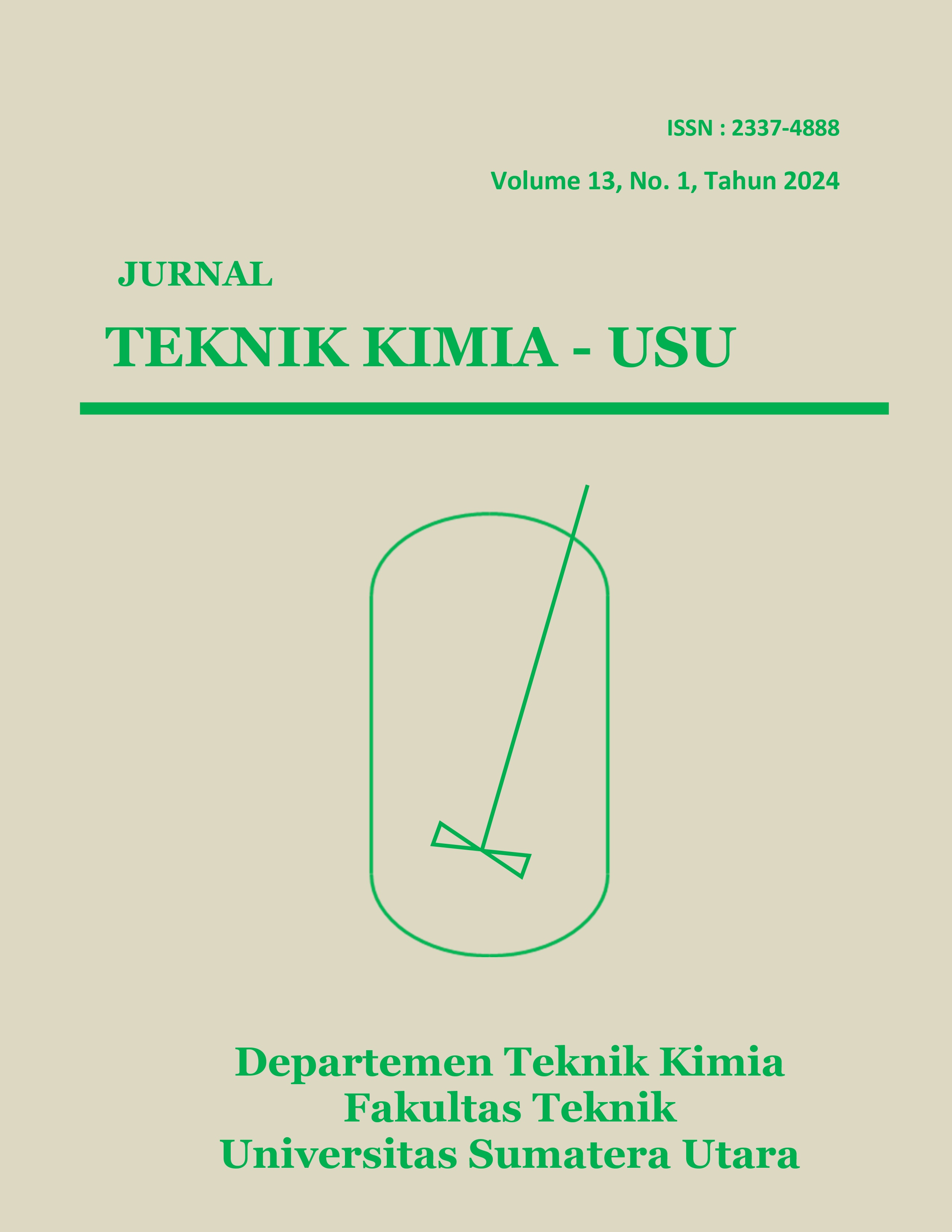Pengaruh Jenis Cairan, Jenis Batang, dan Panjang Batang pada Penentuan Distribusi Ukuran Partikel Bubuk Kaca Menggunakan Buoyancy Weighing-Bar Method (BWM)
DOI:
https://doi.org/10.32734/jtk.v13i1.15766Keywords:
buoyancy weighing bar, particle size distribution, Stokes, glass powder, sodium hexametaphosphateAbstract
Particle size distribution is one of the important physical parameters in industry. A new method has been developed, the buoyancy weighing-bar method to determine the particle size distribution. This study examines the application of the buoyancy weighing-bar method for the determination of the particle size distribution of glass powder. Measurements were made by varying the type of liquid, the type of rod, and the size of the rod length. From this study, it was obtained that the best condition in determining the particle size distribution of glass powder is using aluminum rods with a length of 210 mm in 96% ethanol. The results of determining the particle size distribution of glass powder by using the buoyancy weighing-bar method at the best conditions are comparable to the results of determining the particle size distribution obtained using the settling balance method.
Downloads
References
Nursyamsi, I. Indrawan, and I. P. Hastuty, “Pemanfaatan serbuk kaca sebagai bahan tambah dalam pembuatan batako,†Media Teknik Sipil, vol. 14, no. 1, pp. 84–95, 2016.
S. S. Sejati and L. I. Gunawan, “Serbuk kaca sebagai bahan tambah pembuatan beton normal berdasarkan gradasi pasir zona 3,†Jurnal Media Komunikasi Dunia Ilmu Sipil, vol. 1, no. 1, pp. 7–10, 2019.
M. A. Rivai, S. Kimi, and Revisdah, “Inovasi beton ramah lingkungan,†Bearing: Jurnal Penelitian dan Kajian Teknik Sipil, vol. 6, no. 2, pp. 74–85, 2019.
C. Rahmawati, Muhtadin, M. Faisal, Iqbal, M. Zardi, Meliyana, and Nasruddin, “Teaching industry: Pengolahan limbah kaca menjadi produk konstruksi,†Jurnal Vokasi, vol. 6, no. 2, pp. 112–119, 2022.
E. Obata, Y. Ohira, and M. Ohta, “New measurement of particle size distribution by a buoyancy weighing-bar method,†Powder Technol, vol. 196, no. 2, pp. 163–168, 2009.
T. Motoi, Y. Ohira, and E. Obata, “Measurement of the floating particle size distribution by a buoyancy weighing-bar method,†Powder Technol, vol. 201, no. 3, pp. 283–288, 2010.
T. Allen, Particle Size Measurement, 4th ed. London: Chapman and Hall, 1990.
R. Tambun, N. Pratama, Ely, and F. Hanum, “Measurement of cement’s particle size distribution by the buoyancy weighing-bar method,†J. Sci. Eng, vol. 10, no. 2, pp. 74–77, 2016.
Y. Haryani, G. F. Kartika, Yuharmen, E. M. Putri, D. T. Alchalish, and Y. Melanie, “Pemanfaatan ekstrak air rimpang jahe merah (Zingiber officinale Linn. var. rubrum) pada biosintesis sederhana nanopartikel perak,†Chimica et Natura Acta, vol. 4, no. 3, pp. 151–155, 2016.
O. Yuichi, N. Kazuya, K. B. M. Pa’ad, S. Masamitsu, and H. Hiroto, “Influence of the weighing tool shape and the vessel shape in the buoyancy weighing–bar method on size distribution measurement of floating particle,†Dissertation, Muroran Institute of Technology, Muroran, 2022.
R. Tambun, A. N. Silaen, and I. J. Banjarnahor, “Pengaruh panjang, bentuk, dan jenis batang pada metode pengapungan batang dalam mendeteksi waktu pemisahan kerosin dan air,†Jurnal Teknik Kimia USU, vol. 9, no. 1, pp. 21–25, 2020.
Downloads
Published
Issue
Section
License
Copyright (c) 2024 Jurnal Teknik Kimia USU

This work is licensed under a Creative Commons Attribution-ShareAlike 4.0 International License.

















